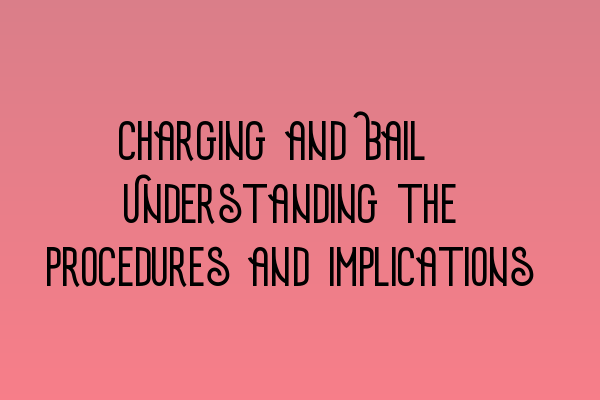Charging and Bail: Understanding the Procedures and Implications
Welcome to SQE Criminal Law & Practice Law UK! In this blog post, we will delve into the procedures and implications of charging and bail in criminal law cases. Whether you are a legal professional, law student, or simply curious about the criminal justice system, this article will provide you with valuable insights.
The Process of Charging
When a crime is committed, the police investigate the matter and gather evidence. If they have sufficient evidence to suggest that a person may be responsible for the crime, they may decide to charge that individual. Charging is the formal process of accusing someone of committing a criminal offense.
Charging individuals involves the presentation of evidence, legal analysis, and the decision-making process. The decision to charge is not taken lightly, as it has significant implications for the accused. The charge determines the severity of the offense and the potential consequences to be faced.
Once a charge has been made, the case enters the judicial system, and the accused will have an opportunity to respond and defend themselves in court. It is worth noting that the charging process can vary depending on the jurisdiction and the specific circumstances of the case.
The Role of Bail
Following the charging process, the question of bail arises. Bail refers to the temporary release of an accused person from custody, with or without conditions, pending further court proceedings. The purpose of bail is to ensure the appearance of the accused in court while also considering any potential risks to public safety or the administration of justice.
When determining whether to grant bail, the court considers several factors, such as the seriousness of the offense, the accused’s criminal history, the risk of flight, and the potential danger posed to the community. The court may impose conditions upon granting bail, such as surrendering passports, regular reporting to a police station, or electronic monitoring.
It is important to understand that the decision to grant or deny bail is not always straightforward. Complex legal arguments may be made by both the prosecution and defense, and a range of factors will be taken into consideration by the court.
The Implications and Consequences
The procedures surrounding charging and bail have significant implications and consequences for all parties involved. For the accused, being charged with a criminal offense can have serious personal, professional, and legal repercussions. It is crucial to have competent legal representation to navigate the complex criminal justice system and mount a robust defense.
Understanding the procedures of charging and bail is not only important for defendants, but also for legal professionals and law students. A solid understanding of these processes is fundamental for effective legal representation, case preparation, and advocacy. By familiarizing oneself with the intricacies of charging and bail procedures, legal professionals can provide the best possible assistance and support to their clients.
For more information about related topics, please refer to the following articles:
- SQE 1 Practice Exam Questions
- SQE 1 Practice Mocks FLK1 FLK2
- SQE 2 Preparation Courses
- SQE 1 Preparation Courses
- SRA SQE Exam Dates
Thank you for reading this blog post on charging and bail procedures. We hope you found it informative and insightful. If you have any further questions or require legal assistance, please do not hesitate to reach out to SQE Criminal Law & Practice Law UK.
